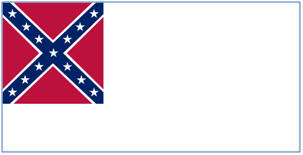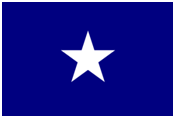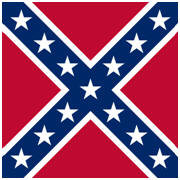Flags of the Confederacy
First national flag ("Stars and Bars")
The first official flag of the Confederacy, called the "Stars and Bars," was flown from March 5, 1861, to May 26, 1863.
The Stars and Bars flag was adopted March 4, 1861 in Montgomery, Alabama and raised over the dome of that first Confederate Capitol.

First national flag with 7 stars
(March 4, 1861 – May 21, 1861)

First national flag with 9 stars
(May 21, 1861 – July 2, 1861)

First national flag with 11 stars
(July 2, 1861 – November 28, 1861)

First national flag with 13 stars
(November 28, 1861 – May 26, 1863)
Second national flag ("the Stainless Banner")
During the solicitation for the second national flag, there were
many different types of designs that were proposed, nearly all
making use of the battle flag, which by 1863 had become well-known
and popular. The new design was specified by the Confederate
Congress to be a white field "with the union (now used as the battle
flag) to be a square of two-thirds the width of the flag, having the
ground red; thereupon a broad saltier [sic] of blue, bordered with
white, and emblazoned with mullets or five-pointed stars,
corresponding in number to that of the Confederate States.
The nickname "stainless" referred to the pure white field. The Confederate Congress debated whether the white field should have a blue stripe and whether it should be bordered in red.

Third national flag ("the Blood Stained Banner")
The third national flag was adopted March 4, 1865, just before the
fall of the Confederacy. The red vertical stripe was proposed by
Major Arthur L. Rogers, who argued that the pure white field of the
second national flag could be mistaken as a flag of truce. When
hanging limp in no wind, the flag's Southern Cross canton
could accidentally stay hidden, so the flag could mistakenly appear
all white.

The Bonnie Blue Flag
In addition to the national flags, a wide variety of flags and banners were flown by Southerners during the War. Most famously, the "Bonnie Blue Flag" was used as an unofficial flag during the early months of 1861. It was flying above the Confederate batteries that first opened fire on Fort Sumter, beginning the Civil War.

The Battle Flag
Often referred to as The battle flag of the Confederacy it was the design that was the basis of more than 180 separate Confederate military battle flags.
The Army of Northern Virginia battle flag was usually square, of various sizes for the different branches of the service: 48 inches square for the infantry, 36 inches for the artillery, and 30 inches for the cavalry. It was used in battle beginning in December 1861 until the fall of the Confederacy. The blue color on the saltire in the battle flag was navy blue, as opposed to the much lighter blue of the Naval Jack.
The flag's stars represented the number of states in the Confederacy. The distance between the stars decreased as the number of states increased, reaching thirteen when the secessionist factions of Kentucky and Missouri joined in late 1861.
The Confederate
Flag
A rectangular variant of the battle flag used by some Confederate Army Units, now called "The Confederate Flag" or "The Confederate Battle Flag", despite its never having historically represented the CSA as a nation, has become a widely recognized symbol of the South. It is also called the "rebel", or "Dixie" flag, and is often incorrectly referred to as the "Stars and Bars" (the actual "Stars and Bars" is the First National Flag, which used an entirely different design).

North
Carolina
This flag was adopted on June 22, 1861, immediately following the state's secession from the Union on May 20, 1861. The date May 20, 1775 is when the Mecklenburg Declaration of Independence made in the Thirteen Colonies during the American Revolution. It was supposedly signed on May 20, 1775, at Charlotte, North Carolina, by a committee of citizens of Mecklenburg County, who declared independence from Great Britain after hearing of the battle of Lexington.

The state legislature adopted this flag in March, 1885, to replace the original state flag that had been adopted on June 22, 1861, immediately following the state's secession from the Union on May 20, 1861. The red field of the old flag was replaced by blue in memory of the Bonnie Blue Flag, which was used as a symbol of secession during the war and flew over the batteries that opened fire on Fort Sumter, beginning the Civil War. The overall stripe pattern is also reminiscent of the "Stars and Bars" flag and the lone star state flag of Texas, also a member of the Confederacy.

Back
